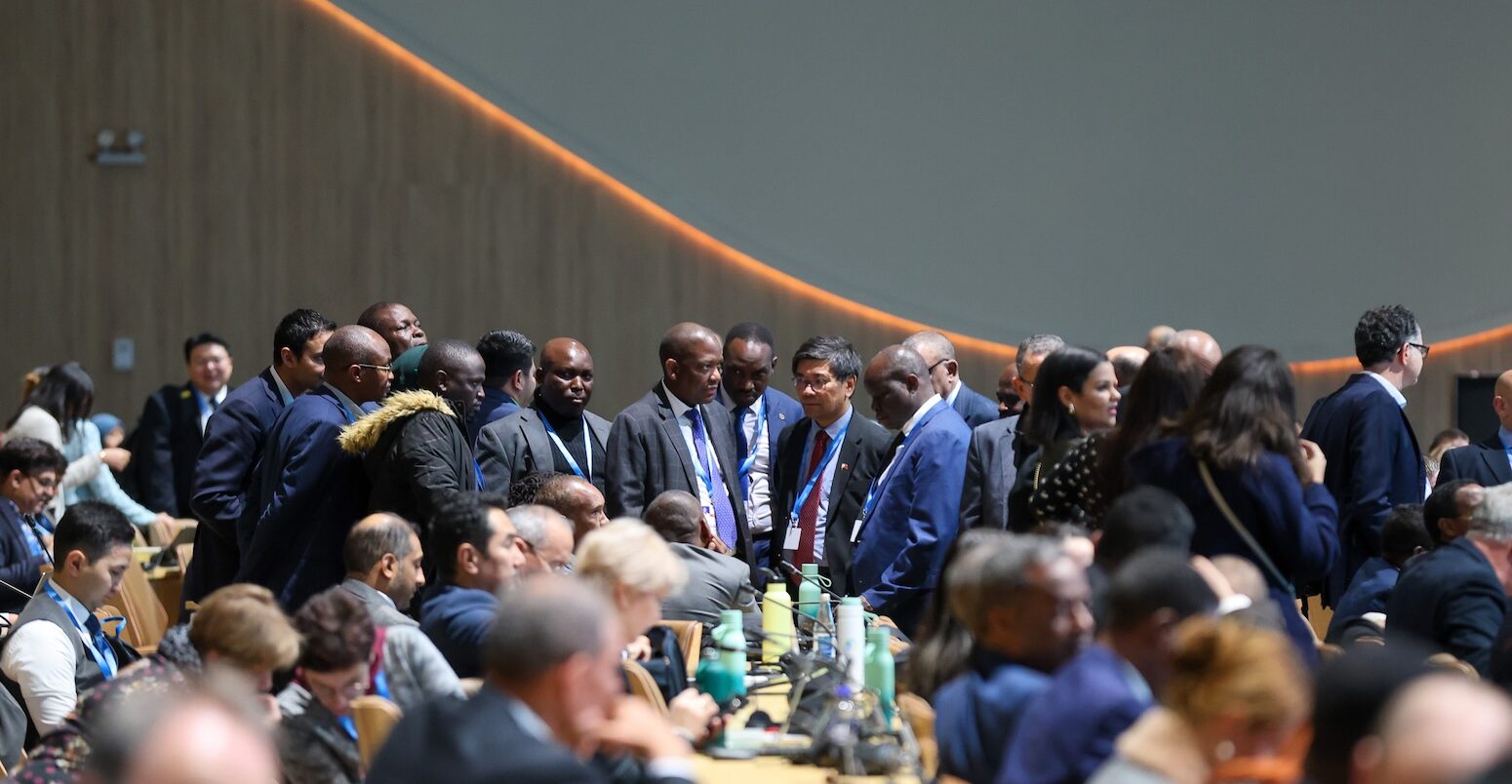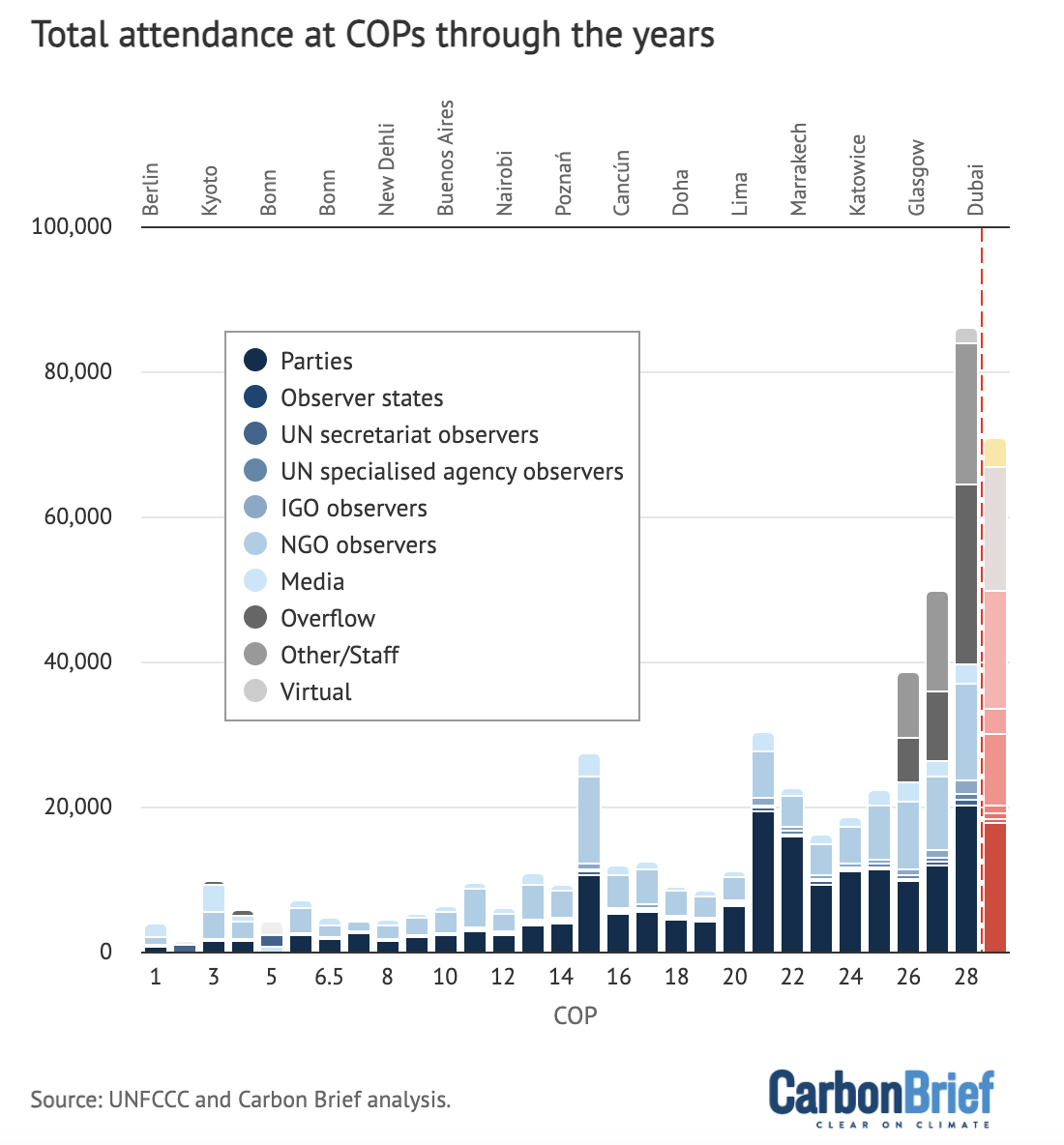
Analysis: Which countries have sent the most delegates to COP29?
Multiple Authors
11.12.24Multiple Authors
12.11.2024 | 2:04pmMore than 65,000 delegates have registered to attend the COP29 climate summit in Baku, Azerbaijan, potentially making it the second-largest COP on record.
This total is more than 15,000 lower than the record-breaking COP in Dubai last year – and marks the first time in seven years that a COP is not larger than its predecessor.
The figures are released amid reports that numerous world and industry leaders are skipping the summit, while Papua New Guinea has pulled its delegation out entirely.
Nonetheless, the size of the Baku summit still likely outstrips major COPs of the past, including Copenhagen, Paris and Glasgow.
COP29 host Azerbaijan has the largest delegation at the summit, with 2,229 people registered for badges. This is followed by Brazil (1,914) and Turkey (1,862) with the second and third-largest delegations, respectively.
The United Arab Emirates (UAE), hosts of COP28 in Dubai, has the fourth-largest delegation (1,011) and China (969) has the fifth.
While China’s delegation is smaller than at COP28 (when it was 1,296), both summits have seen a much larger presence for the country. For the 10 COPs before COP28, China’s average delegation of named participants was around 100 people.
Update 06/12/2024: The UNFCCC has now published the final COP29 participant lists (including full Excel files). A total of 54,148 people attended in person, plus 2,411 online, taking the total number of participants to more than 56,000. This confirms COP29 as the second-largest climate COP in history, with around 30,000 fewer participants than COP28.
All aboard to Baku
COP28 in Dubai last year was the largest COP in an almost 30-year history of summits – by some distance. More than 83,000 people attended the summit in person, beating the previous record of around 50,000 set in Sharm El-Sheikh in Egypt the year before.
The total number of registered delegates for COP29 in Baku clocks in at 66,778 – falling between the totals of the previous two COPs. With 3,975 “virtual” participants, this takes the overall provisional delegate total for COP29 to 70,753. (This is close to the 72,000 figure quoted by Azerbaijan’s president Ilham Aliyev in his opening address at the COP.)
As the chart below shows, this bucks the recent trend that has seen the size of COPs increase every year since the 16,000 participants that travelled to Bonn, Germany, for COP23 in 2017.
It is worth noting that these are provisional figures, based on the delegates that have registered for the summit. The UNFCCC will release the final figures – based on participants collecting a physical badge at the venue – after the summit has closed.

This group adds up to 17,680 delegates – second only to COP28 in Dubai.
At last year’s COP, the participant lists published by the United Nations Framework Convention on Climate Change (UNFCCC) – for the first time – named every single person that had registered for the summit (excluding support staff). Previously, COPs have typically included thousands of “overflow” participants in which countries and UN agencies could nominate delegates without their names appearing on their official lists.
The Baku summit continues this more transparent approach, providing spreadsheets that name all participants.
For consistency with Carbon Brief’s analysis of previous COPs, the above chart includes overflow delegates as a single group. However, the participant lists do divide the overflow delegates between parties and observer groups. Including the overflow numbers takes the total for party representatives to 33,158.
The next-largest group is that of observers from non-governmental organisations (NGOs), which totals 9,881 delegates. This is the third-largest total in COP history (after the previous two COPs).
Along with the NGOs, there are several other groups that fall into the category of “observer organisations” – such as those participants representing UN bodies, intergovernmental organisations, other agencies and business representatives. These total 2,377 registered delegates – or 3,204 when overflow badges are included.
Finally, 3,575 media delegates have registered for COP29, a provisional total that is second only to COP3 in Kyoto in 1997.
Host lead
As is common at COP summits, the largest delegation at COP29 represents the host country. Azerbaijan has registered a delegation – including party overflow badges – of 2,229.
This is a far cry from Azerbaijan’s tiny delegations of the past. Before COP28 in Dubai, Azerbaijan’s delegation amounted to an average of six people.
The second-largest delegation comes from Brazil with 1,914 participants. Brazil typically brings one of the largest delegations and this year is no exception. A substantial delegation from Brazil was also likely considering they will be hosting COP30 next year.
(It is worth noting that some countries allocate some of their party badges to NGOs, which can artificially inflate the size of their official delegation.)
The third-largest delegation comes from Turkey (1,892), followed by UAE (1,011) and China (969). The rest of the top 10 comprises Russia (900), Indonesia (810), Nigeria (634), Japan (595) and Kazakhstan (478).
Just outside the top 10 is the UK in 11th (470), as well as the US (405) in 16th and Australia (394) in 19th.
Azerbaijan has seen the biggest increase in delegation size since COP28, increasing by 995 people. This is followed by Turkey (966 more) and Russia (448).
The smallest delegations belong to Niger and San Marino (two), Nicaragua (three), and Andorra and North Korea (five).
Unsurprisingly, the largest decrease in delegation size is for UEA (dropping by 3,148). Next is India (909) and France (649), while the US delegation has shrunk by 434.
Papua New Guinea has registered a delegation of 28, although prime minister James Marape announced back in August that the country would not be attending to “signal our protest at the big nations…for their lack of quick support to those who are victims of climate change, and those of us who are forest and ocean nations”.
Also, according to the provisional participant lists, Afghanistan has not registered a delegation. However, reports earlier this week suggested that Taliban officials will attend as observers. Therefore, their invitation from COP hosts Azerbaijan may have come outside the usual registration process. Armenia and Myanmar are the other two parties that have not sent a delegation.
The map and table below present the delegation size – split between party and overflow badges – for all the countries registered for COP29. The darker the shading, the more delegates that country has signed up. Use the search box to find the data for a specific party.
Gender split
The UNFCCC’s participant lists typically provide a title – such as Mr, Ms, Sr or Sra – for each registered delegate. In the past, this has allowed Carbon Brief to work out the balance of men to women in the delegations that each country has sent to a COP.
(This analysis always carries the caveat that the titles are designated by UNFCCC and not by Carbon Brief. In addition, Carbon Brief recognises that gender is not best categorised using a binary “male” or “female” label and appreciates that the UNFCCC’s lists may not be wholly accurate.)
However, since COP28 last year, the UNFCCC has started using other titles that do not indicate gender – such as Dr, Prof, Ambassador and Honourable. Therefore, for this analysis, these non-gendered titles – which make up around 150 names of more than 17,000 in the list of party delegates – have not been included.
This gives an average gender balance of party delegations of 60% male to 40% female.
As the chart below shows, this makes COP29 the most balanced COP in history. (Note that, for consistency, the COP28 and COP29 figures only include those on party badges, not overflow ones.

There are two all-male party delegations this year – North Korea (five delegates) and Niger (two delegates).
In addition, this year, Carbon Brief’s analysis reveals that the gender balance across all registered delegates – both in-person and virtual – for COP29 is 59% male to 41% female.
The full list of COP29 party delegation sizes can be found here.
Article by Robert McSweeney. Data analysis by Robert McSweeney and Verner Viisainen. Charts and map by Tom Prater and Joe Goodman.





